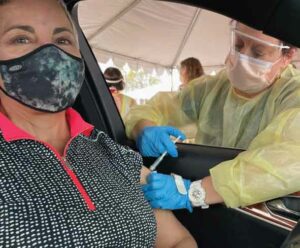The Many Faces of Vaccination
You’ve seen the photos on social media—your fellow dental hygienists proudly showing their upper arms while being vaccinated against the SARS-CoV-2 virus.

dose of the COVID-19 vaccine.
You’ve seen the photos on social media—your fellow dental hygienists proudly showing their upper arms while being vaccinated against the SARS-CoV-2 virus. It’s been a widespread phenomenon meant to instill confidence in the vaccine, along with demonstrating that dental hygienists care about protecting not only themselves but their patients, families, and friends. Unfortunately, some—including healthcare workers—have been reticent to be vaccinated. A recent survey* by the Kaiser Family Foundation (KFF) found that approximately 30% of healthcare workers indicated they probably or definitely would not get vaccinated.1 About one-fourth of the general public is hesitant to receive the vaccine. It’s especially disturbing to hear about viable vaccine doses being discarded due to expiration, as happened in New York.2 The reasons for hesitancy include:
- Concerns about side effects
- Lack of trust in the government
- Anxiety about the newness of the vaccine
- Worry about the role of politics in the vaccine’s development
THE SOCIAL MEDIA CAMPAIGN WITH IMAGES OF DENTAL HYGIENISTS TAKING THEIR SHOT PLAYS AN IMPORTANT ROLE IN INSTILLING CONFIDENCE IN THE GENERAL PUBLIC.
The KFF suggests a targeted educational campaign is needed to generate enthusiasm for getting vaccinated. The foundation has identified the following key groups that need tailored messaging about COVID-19 vaccines: “as soon as possible” group, “wait and see” group, “only if required” group, and “definitely not” group. When described in these term, it’s easy to see how different messages are needed to promote vaccination. It’s also apparent that trust is a major factor in attaining widespread acceptance.
A novel approach is being used by the state of West Virginia.3 The state rejected a federal partnership with larger, nationwide chain pharmacies and instead uses “mom and pop” pharmacies to distribute the vaccine. As a result, more people per capita have received the first dose of the vaccine in West Virginia than any other state. West Virginia was also the first state to offer the initial doses of the vaccine to long-term care facilities in December 2020. The state expects to complete second doses in those facilities by the end of January. As of January 17, at least 7.5% of people in the state had received their initial vaccination. Alabama and Georgia are lowest on the scale, with initial vaccination rates of 2.1% and 2.2%, respectively. The two most populous states—California and Texas—are at 2.7% and 4.0%, respectively.
The social media campaign with images of dental hygienists taking their shot plays an important role in instilling confidence in the general public. Dental hygienists are widely trusted and respected by the community, and this is yet another way for us to advocate for health.
Jill Rethman, RDH, BA
Editor in Chief
jrethman@belmontpublications.com
*The KFF survey was conducted in December 2020. Updates are not yet available and it’s possible the results could change.
REFERENCES
- Hamel L, Kirzinger A, Muñana C, Brodie M. KFF COVID-19 vaccine monitor: December 2020. Available at: click here. Accessed January 18, 2021.
- Dean G. New York expands its COVID-19 vaccine pool by 3.2 million people after a lack of eligible candidates forced healthcare workers to toss spare doses. Available at: click here. Accessed January 20, 2021.
- Dil C. “Little old West Virginia” sets pace on vaccine rollout. Available at: click here. Accessed January 18, 2021.
From Dimensions of Dental Hygiene. February 2021;19(2):6.

